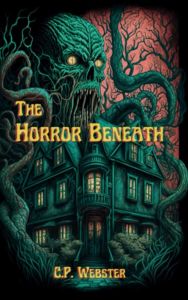Cthulhu and a Cuppa: C. P. Webster’s Veddy British Horror
C. P. Webster
The Horror Beneath
Independently published, 2023
“Whatever the history of the house, Wingood felt confident that von Hallerstein had not been carried off by vengeful spirits. No, von Hallerstein was too substantial a man for that.”
How this excellent novella reached my hands is a story that must be told!
I had finally resolved upon answering the incessant knocking upon the door of my isolated villa only so as to deliver a sound upbraiding to whomever it was who braved the howling winds to disturb the hushed retreat in which I had sought solace from a life devoted to eldritch adventures. Flinging open the thick oaken door I could see nothing, until a flash of lightning illuminated the twisted, hooded figure that I knew only as “The Editor.”
“Here,” he gurgled thickly, thrusting a manuscript into my hands, “you’ll like this. It’s sort of Lovecraft meets Hammer Horror. And you’ll like the length, only about 150 pages. What’s that Henry James line you like to quote, ‘the dear, the blessèd nouvelle’?”
Then the crack of the inevitable corresponding peal of thunder finally sounded and mercifully left me senseless on the floor of the antechamber. On recovering, the figure was gone, as was the manuscript; only a foetid odor of some damned and damnable ichor remained. Only some time later did I discover the file that had somehow lodged itself on my laptop: this book.
C. P. Webster was hitherto unknown to me, but apparently he is a “seasoned veteran” from the United Kingdom who now publishes among an “underground fiction” circle known as The Bizarchives, also unknown to me. On the basis of this novella, I must seek out more of both — whatever the risks — and I recommend that to you, dear Constant Reader, as well.
The publisher has chosen to be a bit secretive on Amazon:
England, The estate of Marchley Howe holds a deep and primordial secret. After realtor Clive Wingood finally sells it to an eccentric German author, Marchley Howe’s new owner goes missing. Clive then finds himself unraveling the truth about what ancient horrors slumber deep within the earth’s bowels.
Well, one doesn’t want too many “spoilers” and all that. But the potential reader may want to know that this is a Lovecraftian tale, which may or may not encourage the reader (it does me). But Webster has chosen, wisely, not to write his Lovecraftian story by competing in the eldritch adjective department — which few handle well, usually producing an unintentional pastiche or parody, and which also remains the area where Lovecraft is most controversial.[1] Apart from an occasional “cyclopean,” the emphasis is on the story itself, with the Lovecraftian element coming from the narrative beats themselves.
All the elements are here: the ancient house built on the more ancient priory, built on an even yet more ancient well; the cursed tome — in this case, De Vermis Mysteriis, or Mysteries of the Worm, actually a Robert “Psycho” Bloch invention that Lovecraft himself assimilated to the Cthulhu lore; the protagonist, innocent and ignorant but somehow drawn to the mystery; the eccentric local historian who does a pretty good job as an Indiana Jones-style ghostbuster in tweeds; the revelation of the thing that still lives down there. It’s kind of a mash-up of “The Rats in the Walls” and “The Statement of Randolph Carter,”[2] with a bit of At the Mountains of Madness as well. The eponymous horror when it finally appears in well-done and reasonably original, although the eyes and pseudopods reminded me a bit of Clark Ashton Smith’s “The Dweller in the Gulf.”

You can buy James O’Meara’s book The Eldritch Evola here.
Rather than trying to imitate Lovecraft’s language, Webster’s innovations here are twofold. First, he’s set his tale in the England in the ‘70s — hence the Hammer Horror reference above — which provides a nice retro feel.[3] Of course, he does provide the usual dated entries, but mostly it’s conveyed through subtle details; I particularly liked our hero tooling along in his Jag, chilling out to the smooth sounds of Andy Williams on his cassette player.
Continuing to the cinematic angle, it’s easy to imagine Von Hallerstein, the mysterious German (or “Jerry,” as our ghostbuster likes to call him), as Peter Cushing. Goodwin is too bland for Christopher Lee, however; perhaps a smooth-smoothy like Ian Ogilvy[4] would do. Ghostbusting Antrobus could be a good role for Michael Gough,[5] or perhaps better Andrew Keir.[6] The role of the sneaky, officious Presbyterian police inspector would give Edward Woodward a chance to revisit his role in The Wicker Man.
Another original angle, which may be of interest to our readers, is that Webster brings in the Ahnenerbe as part of his backstory and buildup to the climactic revelation. I wouldn’t necessarily say that Webster thinks Team 1488 are the Good Guys, but perhaps his perspective of Lovcraftian Cosmism leaves him free to use them like the many other historical figures and groups that crop up in such tales, such as John Dee, militant monks, the Roman legions, or the Templars.[7]
Moreover, our intrepid ghostbuster seems a bit more based than the usual scholarly incel:
“Do you know Clive,” Antrobus continued, “my family has been farming this land since records began. We spilt blood for it, cleared it, tamed it, and finally prospered on it. There’s a mention of us in the Domesday Book as tenants under Earl Hugh of Deva. My lad runs the farm now, and one day it will be his. This place means something to me. . . .”
Antrobus bent down and touched the ground at his feet and looked up at Wingood.
“Do you know, while I’ve a breath left in me, I’d rather be damned than stand by and let some dark thing . . . some ‘Black Worm’, whatever it is, creep into my county.”
Webster is also the author of Albion: ARVA — VALA — DEVA, a trilogy dealing with supernatural events in an alternate, post-epidemic dystopian England (is there any other?), and based upon my reading of this novella it should be worth a read as well. Go and do likewise, before it’s . . . too late.
* * *
Counter-Currents has extended special privileges to those who donate $120 or more per year.
- First, donor comments will appear immediately instead of waiting in a moderation queue. (People who abuse this privilege will lose it.)
- Second, donors will have immediate access to all Counter-Currents posts. Non-donors will find that one post a day, five posts a week will be behind a “Paywall” and will be available to the general public after 30 days.
- Third, Paywall members have the ability to edit their comments.
- Fourth, Paywall members can “commission” a yearly article from Counter-Currents. Just send a question that you’d like to have discussed to [email protected]. (Obviously, the topics must be suitable to Counter-Currents and its broader project, as well as the interests and expertise of our writers.)
To get full access to all content behind the paywall, sign up here:
Paywall Gift Subscriptions
 If you are already behind the paywall and want to share the benefits, Counter-Currents also offers paywall gift subscriptions. We need just five things from you:
If you are already behind the paywall and want to share the benefits, Counter-Currents also offers paywall gift subscriptions. We need just five things from you:
- your payment
- the recipient’s name
- the recipient’s email address
- your name
- your email address
To register, just fill out this form and we will walk you through the payment and registration process. There are a number of different payment options.
Notes
[1] I mean, other than the “racism” and “sexism” and, I suppose, “transphobia” (see: “The Thing on the Doorstep”); see “Reflections on the H. P. Lovecraft Award.”
[2] One kept waiting for something like “You fool, Warren is dead!” to crackle over the walkie-talkie. It occurs to me to ask why Lovecraft never used the two-man format very much in later writings, preferring to have a single protagonist witness the unspeakable and indescribable.
[3] While Lovecraft set a few tales in England, such as “The Rats in the Walls,” he seldom spent any time establishing the atmos, preferring to dive right into the decaying priory stuff. One might compare this to a British, but non-Hammer, adaptation of Lovecraft’s “The Shuttered Room” (David Greene, 1967), set in contemporary rural England. Interestingly, an Internet Movie Database reviewer points out that, stripped of the Lovecraft elements, this narrative essentially suggests Sam Peckinpah’s Straw Dogs; imagine Peckinpah directing Lovecraft!
[4] “He co-starred with Boris Karloff in The Sorcerers (1967); with Vincent Price in Witchfinder General (also known as The Conqueror Worm, 1968); with Meryl Streep and Goldie Hawn in Death Becomes Her (1992); with Peter Cushing in two films for horror specialists Amicus among others. He was a friend of the film-maker Michael Reeves and starred in all three of Reeves’s films: Revenge of the Blood Beast (1966), The Sorcerers and Witchfinder General.” (Wikipedia)
[5] “He is known for his roles in the Hammer Horror Films from 1958, with his first role as Sir Arthur Holmwood in Dracula, and for his recurring role as Alfred Pennyworth from 1989 to 1997 in the four Batman films directed by Tim Burton or Joel Schumacher. He appeared in three more Burton films: Sleepy Hollow, voicing Elder Gutknecht in Corpse Bride and the Dodo in Alice in Wonderland.” (Wikipedia)
[6] “It was in films where he became most prominent during the 1960s and early 1970s, particularly in Hammer’s famous range of ‘Hammer Horror’ productions. He appeared in Pirates of Blood River (1962), Dracula: Prince of Darkness (1966), The Viking Queen (1967) and Blood from the Mummy’s Tomb (1971). By far his most prominent role for Hammer came in 1967’s Quatermass and the Pit; this remained one of Keir’s personal favourite roles of his career, and his obituary in The Independent claimed that ‘Keir’s mixture of gruff determination, intelligence and quirkiness made him the definitive professor.’ In 1966, Keir joined the cast list of the second Doctor Who big screen adventure, Daleks’ Invasion Earth 2150 A.D., alongside Peter Cushing.” (Wikipedia)
[7] Along the way, a very minor character, just mentioned in passing, is given the name of a venerable figure of the English New Right; keep your eyes open for it!



